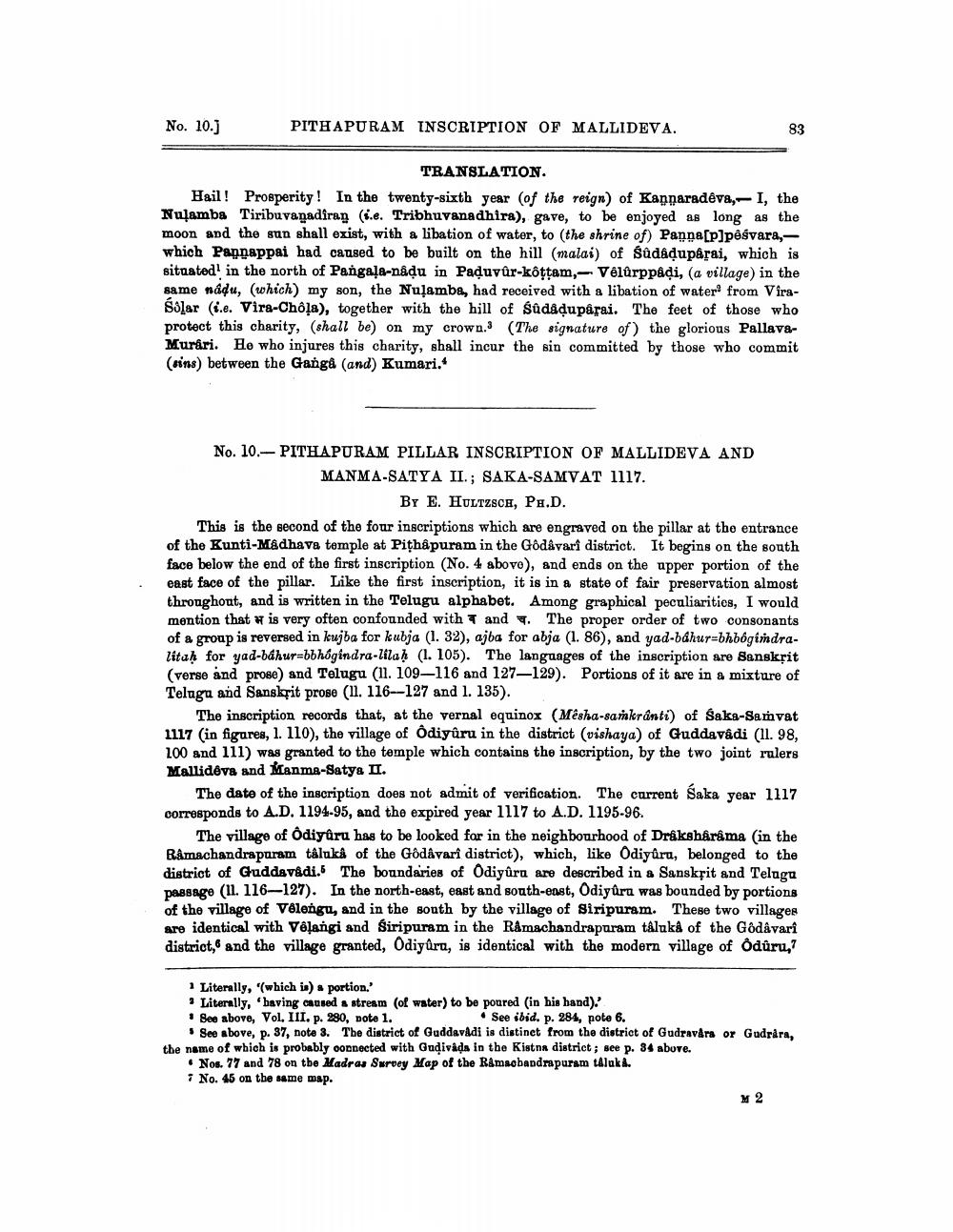________________
No. 10.]
PITHAPURAM INSCRIPTION OF MALLIDEVA.
83
TRANSLATION.
Hail! Prosperity! In the twenty-sixth year (of the reign) of Kannaradeva,— I, the Nulamba Tiribuvanadîran (s.e. Tribhuvanadhira), gave, to be enjoyed as long as the moon and the sun shall exist, with a libation of water, to (the shrine of) Panna[p]pėsvara,which Pannappai had caused to be built on the hill (malai) of Sûdâḍupârai, which is situated in the north of Pangala-nâḍu in Paḍuvûr-kôṭṭam,- Vélûrppâḍi, (a village) in the same nádu, (which) my son, the Nulamba, had received with a libation of water from ViraSolar (e. Vira-Chôla), together with the hill of Sûdâḍupârai. The feet of those who protect this charity, (shall be) on my crown.3 (The signature of) the glorious PallavaMurari. He who injures this charity, shall incur the sin committed by those who commit (sins) between the Ganga (and) Kumari.
No. 10. PITHAPURAM PILLAR INSCRIPTION OF MALLIDEVA AND MANMA-SATYA II.; SAKA-SAMVAT 1117.
BY E. HULTZSCH, PH.D.
This is the second of the four inscriptions which are engraved on the pillar at the entrance of the Kunti-Madhava temple at Pithapuram in the Gôdâvarî district. It begins on the south face below the end of the first inscription (No. 4 above), and ends on the upper portion of the east face of the pillar. Like the first inscription, it is in a state of fair preservation almost throughout, and is written in the Telugu alphabet. Among graphical peculiarities, I would mention that is very often confounded with and. The proper order of two consonants of a group is reversed in kujba for kubja (1. 32), ajba for abja (1. 86), and yad-báhur-bhbôgimdralitaḥ for yad-báhur-bbhógindra-lilah (1. 105). The languages of the inscription are Sanskrit (verse and prose) and Telugu (11. 109-116 and 127-129). Portions of it are in a mixture of Telugu and Sanskrit prose (11. 116--127 and 1. 135).
The inscription records that, at the vernal equinox (Mêsha-samkranti) of Saka-Samvat 1117 (in figures, 1. 110), the village of Ôdiyûru in the district (vishaya) of Guddavâdi (11. 98, 100 and 111) was granted to the temple which contains the inscription, by the two joint rulers Mallidêva and Manma-Satya II.
The date of the inscription does not admit of verification. The current Śaka year 1117 corresponds to A.D. 1194-95, and the expired year 1117 to A.D. 1195-96.
The village of Ôdiyûru has to be looked for in the neighbourhood of Draksharama (in the Ramachandrapuram talukâ of the Gôdâvarî district), which, like Odiyûru, belonged to the district of Guddavadi. The boundaries of Odiyûra are described in a Sanskrit and Telugu passage (11. 116-127). In the north-east, east and south-east, Odiyûra was bounded by portions of the village of Vêlengu, and in the south by the village of Siripuram. These two villages are identical with Vêlangi and Siripuram in the Ramachandrapuram taluka of the Gôdâvarî district, and the village granted, Odiyûru, is identical with the modern village of Ôdûru,"
1 Literally, "(which is) a portion.'
Literally, having caused a stream (of water) to be poured (in his hand).'
See above, Vol. III. p. 230, note 1.
See ibid. p. 284, pote 6.
See above, p. 37, note 3. The district of Guddavadi is distinct from the district of Gudravåra or Gudrára, the name of which is probably connected with Gudivada in the Kistna district; see p. 34 above.
Nos. 77 and 78 on the Madras Survey Map of the Ramachandrapuram taluka. 7 No. 45 on the same map.
M 2




